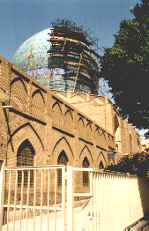|
|
Chahar Baq School, also named "Sultani", "Madar-Shah" and "Shah Sultan Hussein School", is one of the five schools built in the reign of Shah Sultan Hussein (1694-1723), last king of Safavid era.
Although the date of establishment of this building corresponds the fall of political power of Safavid, it would be considered as a masterpiece specimen of the architecture of that period and the result of more than one century of experience gained during architecture period of the reign of Safavid.
With regard to the policy of Safavid, many schools were built in their era in Iran, to the extend that sometimes the statistics regarding the number of such schools, recorded in historic and travel books, seem incredible.
Shah Sultan Hussein was very much cared for theological sciences and himself was among the seekers of such science. During his kingdom, the process of theological school building augmented and led to the establishment of the most magnificent specimen.
Establishment expenses of this largest school of Safavid era, with 12,000 Sq. m area and 121 rooms, was paid by king's mother. The revenue of two important complexes "Bazarcheh-Boland" (today: Art Bazaar) , situated in the North of the school, and "Madar-Shah Caravansary" (today: Shah Abbas Hotel) in North, was dedicated to it.
The school was equipped with such facilities as kitchen and library. Contrary to the most of the ancient schools, which were built in bazaar, it was built along-side the complex of royal gardens and palaces, in Chahar Baq Avenue, the most important avenue of the city. In order to design and plan this school, foremost artists of the period of different specialties were employed.
The set of such factors caused revolution in design of schools, as such it affected the architecture of most of the schools, which were built in following periods. Worship room of the school was changed to a mosque, with dome and minarets. With "Farshadi Stream" (Madi), passing through its yard, and bordering little gardens with plenty of trees, the court of the school resembled a garden. Being situated alongside the main avenue of the city, its exterior facade was given important and magnificent aspect in a way that its dome and minarets were considered as indicative sign of the city.
Preciousness of the architecture of the school is not limited to its design and over-all constitution. Its decoration are extraction of experiences of the artists of Safavid era. Maybe, this building would be considered as a treasure of the most precious tile works, calligraphy, sculpture, mosaic works, gold works, silver works and painting.
Among the beautiful parts of the school, one would mention the entrance vestibule (levee) and the appropriated room of Shah Sultan Hussein, the first room of Northern front from West, in which he was imprisoned and killed by Afghans.

|
|

